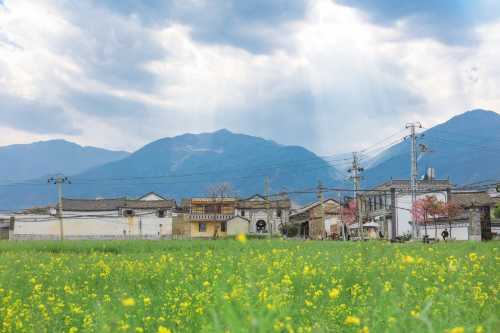Popular Trip Moments
Shuanglang Ancient Town, Dali: A Kaleidoscope of Seasonal Colors | Dali's Magical Adventure: Transform Your Little One into a Bai Warrior on an Erhai Lake Excursion | Dali's 2-Hour Erhai Lake Secret Realm! 5-Year-Old Chasing Seagulls | ### 4 Must-See Attractions in Yunnan: A Perfect Blend of Nature and Culture | How to Choose a B&B in Dali: The Honest Truth After Staying at These 11 Places | Yunnan: Your Dream Destination for Romance and Adventure | Sanview Hotel | A Window to the World | Encounter Naliya: A Hidden Garden by Erhai Lake in Dali | Here's how to choose a lakeside seaview homestay in Shuanglang | Dali Erhai Lake | An Encounter with Romance | Luye Lusheng Guesthouse in Dali Ancient City | Pullman Dali Resort | Dali Songyun Cliff Hotel | Discover your dream ocean view room by Erhai Lake, where you can relax on the balcony | Yunnan Border: A Hidden Gem Nestled Among Mountains and Rivers | Plan Your 8-Day Yunnan Trip Like This | Enjoy Starlight on Erhai Lake at This Luxurious French-Style Seaview Homestay | I'm in a Greek movie! I found a pure white palace that sings by the Erhai Lake! | Kong Yuan Zi: A Super Photogenic Detached Courtyard Near Dali Ancient City | First time in Dali? No problem! Head to these six places without hesitation | I spent a night in the room closest to Erhai Lake. | Sanse Yunhe | Live by Erhai Lake and immerse yourself in the scenery in a second! | Step into a Fairytale! This Homestay in Shuanglang, Dali, is Breathtakingly Beautiful | The right way to experience Erhai Lake! This hotel is stunning. | Dali Erhai | Stunning Sunset Hotel | "Wenbi Village | The 'Santorini' by Erhai Lake, Experience Dali's Blue and White Romance" | Dali Homestay √ All worries disappear when watching the sunrise over the mountains | Dali Treasure Hotel | Damei Huasu · Dali Shuanglang Luna Seaview Hotel | Everyone who comes to Erhai Lake should stay here!! | Head to the spring of March and discover the meaning of vacation
Recommended Attractions at Popular Destinations
Bangkok attraction near me | Manila attraction near me | Tokyo attraction near me | Taipei attraction near me | Hong Kong attraction near me | Seoul attraction near me | Kuala Lumpur attraction near me | Los Angeles attraction near me | Shanghai attraction near me | New York attraction near me | Shenzhen attraction near me | Osaka attraction near me | Singapore attraction near me | London attraction near me | Guangzhou attraction near me | San Francisco attraction near me | Beijing attraction near me | Macau attraction near me | Bali attraction near me | Jakarta attraction near me | Paris attraction near me | Ho Chi Minh City attraction near me | Istanbul attraction near me | Phuket attraction near me | Chicago attraction near me | Seattle attraction near me | Toronto attraction near me | Orlando attraction near me | Cebu attraction near me | Chiang Mai attraction near me
Popular Restaurants in Dali
Fireplace Image Wild Mushroom Courtyard Hot Pot | Wozai Dali Dengni | 双廊转角食光·云南菜·花园餐厅 | Ruoshui 3000 Restaurant | Moshanghuayuan Restaurant | Linden Centre | Er Yue Restaurant | 红利私厨•白族私房菜(玉洱路老店) | Green Field Kitchen | 四方街食店 | 丽舍咖啡吧 | 格外小馆(双廊店) | 醉琉璃·藏好私房菜 | 老宅子私房菜馆(大理古城店) | ba mu xuan | Those flowers, Dali cuisine, wild mushroom hot pot (Gucheng Shop) | 正宗保山铜瓢牛肉(五台路店) | 香村老汉木桶鱼.酸菜鱼(开发区火车站店) | Royal Restaurant | Duan Gongzi's Dali Bai Ethnic Cultural Experience Restaurant | 大理悦湾·VILLA半山海景酒店·咖啡厅 | Baizufengweiguan (dafei) | Ting Yuan· Private Kitchen | Yun Qin | FORTEN | 留白LIUBAI·菡萏驿海景度假酒店·留白Villa·菡萏驿海景餐厅(双廊店) | 凤翔饭庄·洱海畔的味道 | 复兴小院·私房菜(古城店) | Fly Me To The Moon | Jin Sheng You Yuan
Popular Ranked Lists
Top 20 Local Restaurants in Fukuoka | Popular Local Restaurants in Tianjin | Popular Luxury Hotels Near Montelimar | Popular Luxury Hotels in Astana | Popular Best Things to Do in Huangshi | Popular Best Things to Do in Jurong | Popular Luxury Hotels Near Fishers | Popular Best Things to Do in Jishou | Top 5 Best Things to Do in Hinggan League | Popular Luxury Hotels in Al Ula | Popular Local Restaurants in Changsha | Popular Luxury Hotels Near Varberg | Popular Best Things to Do in Wuzhong | Popular Local Restaurants in Sanya | Popular Best Things to Do in Heze | Top 10 Luxury Hotels in Red Sea Governorate | Top 3 Best Things to Do in Shuozhou | Popular Luxury Hotels Near Norwich | Popular Premium Hotels Near Geraldine | Popular Best Things to Do in Zhongxiang | Top 20 Local Restaurants in Nanjing | Popular Best Things to Do in Danba | Top 4 Best Things to Do in Dongfang | Popular Best Things to Do in Neijiang | Popular Luxury Hotels Near Higashiagatsuma | Top 18 Local Restaurants in Seoul | Popular Luxury Hotels in Wilaya de Fes | Popular Local Restaurants in Xi'an | Popular Luxury Hotels Near East Brunswick | Top 3 Best Things to Do in Fuzhou
Payment Methods
Our Partners
Copyright © 2025 Trip.com Travel Singapore Pte. Ltd. All rights reserved
Site Operator: Trip.com Travel Singapore Pte. Ltd.
Site Operator: Trip.com Travel Singapore Pte. Ltd.









